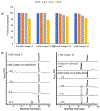Exploration of Structure-Activity Relationship of Aromatic Aldehydes Bearing Pyridinylmethoxy-Methyl Esters as Novel Antisickling Agents
- PMID: 33205981
- PMCID: PMC7869023
- DOI: 10.1021/acs.jmedchem.0c01287
Exploration of Structure-Activity Relationship of Aromatic Aldehydes Bearing Pyridinylmethoxy-Methyl Esters as Novel Antisickling Agents
Abstract
Aromatic aldehydes elicit their antisickling effects primarily by increasing the affinity of hemoglobin (Hb) for oxygen (O2). However, challenges related to weak potency and poor pharmacokinetic properties have hampered their development to treat sickle cell disease (SCD). Herein, we report our efforts to enhance the pharmacological profile of our previously reported compounds. These compounds showed enhanced effects on Hb modification, Hb-O2 affinity, and sickling inhibition, with sustained pharmacological effects in vitro. Importantly, some compounds exhibited unusually high antisickling activity despite moderate effects on the Hb-O2 affinity, which we attribute to an O2-independent antisickling activity, in addition to the O2-dependent activity. Structural studies are consistent with our hypothesis, which revealed the compounds interacting strongly with the polymer-stabilizing αF-helix could potentially weaken the polymer. In vivo studies with wild-type mice demonstrated significant pharmacologic effects. Our structure-based efforts have identified promising leads to be developed as novel therapeutic agents for SCD.
Figures














References
-
- Pauling L; Itano HA; Singer SJ; Wells IC Sickle Cell Anemia, a Molecular Disease. Science 1949, 110, 543–548. - PubMed
-
- Cretegny I; Edelstein SJ Double Strand Packing in Hemoglobin S Fibers. J. Mol. Biol 1993, 230, 733–738. - PubMed
-
- Ferrone FA Polymerization and Sickle Cell Disease: A Molecular View. Microcirculation 2004, 11, 115–128. - PubMed
Publication types
MeSH terms
Substances
Grants and funding
LinkOut - more resources
Full Text Sources
Medical

